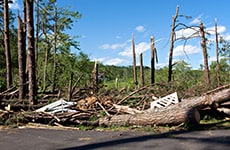Alabama

- State Population: 5,074,296
- Local Health Departments: 66
- Frequent Public Health Emergencies: Tornadoes, Flooding, Tropical Storms/Hurricanes
- Key Emergency Operations Center Activations:
2020 – COVID-19 Pandemic - CDC PHEP Funding:
FY 2022: $9,021,541
FY 2021: $8,892,198
FY 2020: $8,740,894 - Public Health Crisis Response Funding:
Mpox 2023 Funding: $523,695
COVID-19 2021 Funding: $29,676,838
COVID-19 2020 Funding: $8,148,799
- Epidemiologists: 2
- Laboratorians: 5
- Nurses: 7
- Planners: 2
- Other: 32*
*Includes IT specialists, administrative staff, statisticians, and other positions
- 1 Career Epidemiology Field Officer
- Public Health Surveillance and Epidemiologic Investigation
- Public Health Laboratory Testing
- Community Preparedness
- Emergency Operations Coordination
- Medical Countermeasure Dispensing and Administration

In 2018, Alabama used PHEP funding and PHEP-supported staff to hold four workshops with partners on how to stop communicable diseases from entering the state. Participants included representatives from airport emergency medical services, cruise lines, and customs and border protection. At the workshops, participants developed a comprehensive response plan for identifying and mitigating potential travel-associated outbreaks. In an outbreak scenario, having trained, coordinated staff across agencies will reduce the threat of communicable diseases entering Alabama.

A PHEP-funded epidemiologist in Alabama investigated an increase in severe adverse reactions to synthetic cannabinoids using the state’s existing emergency medical services data collection system. She tracked reports of these adverse reactions, which included difficulty breathing, elevated blood pressure, and seizures. Her investigation identified nearly six times more calls for synthetic cannabinoid exposure in April and May than in the previous three months. Because of this tracking method, the state could alert providers to consider synthetic cannabinoid exposure as a diagnosis, and provide health information to the public. The number of emergency calls returned to pre-event levels by June.

In 2011, Alabama responded to the largest emergency in state history—a severe weather outbreak with 62 confirmed tornadoes. Two hundred forty-seven people died, hundreds were injured, and thousands were left homeless in this disaster. The Alabama Department of Public Health used PHEP funds to open two medical needs shelters, provided public health nurses to support a local hospital, established a mobile pharmacy, and collaborated with partners to process more than 200 human remains.